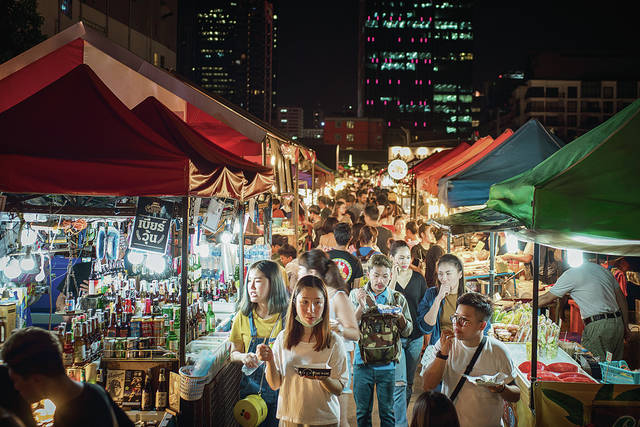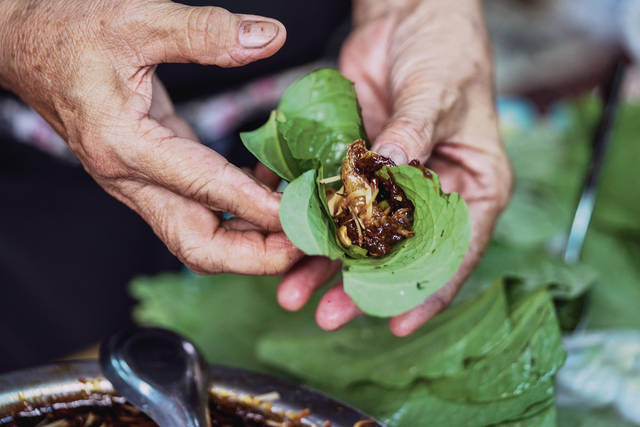Where to find Bangkok’s best street food while you can

NEW YORK TIMES
Young locals and tourists eat and wander around the streets of the Train Night Market Ratchada in Bangkok.

NEW YORK TIMES
Customers eat at a popular curry street restaurant near Chinatown in Bangkok.

NEW YORK TIMES
A big meal consisting of a seafood platter, pork ribs and Isan dishes like papaya salad or pork salad, at the Train Night Market Ratchada.

NEW YORK TIMES
A vendor sells moo ping (grilled pork) early in the morning in the business area of Sathorn.

NEW YORK TIMES
A vendor wrapping a miang kham — dried shrimp, peanuts, onion, coconut, lime, chili and coconut caramel wrapped in a leaf — which will be sold later as a snack in the Chinatown district of Bangkok.





It was a few minutes after 6 p.m., and Lim Lao Sa, a fish ball noodle stand tucked into an alleyway near the Chao Phraya River in Bangkok, had just opened. Rain was falling, hard. A series of deftly arranged tarps sheltered patrons sitting on red plastic stools at a handful of tables. Water drizzled off the tarp edges, down the concrete walls and past exposed wiring. Fluorescent bulbs cast harsh shadows. Lim Lao Sa’s owners — a brother and sister who had inherited the 60-year-old business from their father — bickered vigorously.
My friend Win Luanchaison, a real-estate developer and fervent culinary explorer, and I tucked into our bowls. The quenellelike fish balls were at once springy and creamy, the rice noodles supple, the broth clear and sure of purpose.
It was easy to understand why Lim Lao Sa cooked annually for Thai Princess Maha Chakri Sirindhorn. “She eats egg noodles served dry,” said Pawita Boriboonchaisiri, the sister.
>> Finding street food in Bangkok is easy — you’ll see fish ball and satay stands parked, it seems, in front of nearly every 7-Eleven — but finding the really good stuff takes a little more effort, and a bit of wandering.
>> Chinatown is an excellent place to begin, for its density of talented vendors and for the official protection they enjoy (at least for the moment). Yaowarat Road is the heart of its street-food zone — think rolled rice noodles with crispy pork belly, or sweet boiled lotus root on crushed ice — but if you wander a little farther afield, you’ll encounter the fish ball-noodle stand Lim Lao Sa (on Song Wat Road near Trok Saphan Yuan), Natthapon Coconut Ice Cream (on Phraeng Phuthon Road), and the high-end drinking-food restaurant Err (394/35 Maha Rat Road; errbkk.com).
>> For a stroll through not-yet-gentrified Bangkok, take the Sky Train to Udom Suk station and head down Sukhumvit Road soi 103, through numerous vendors crowding the sidewalk. (Try them!) To the left, in the marketplace, is a bamee moo daeng stall that makes its own excellent noodles, and a few blocks northeast is Sai Kaew, the duck noodle soup shop.
>> To see another way street food is evolving, check out Talad Ruam Sab, known as the Lunch Market, across Asok Road (Sukhumvit soi 21) from Srinakharinwirot University. There you’ll find dozens of tiny stalls serving items like sweet braised pig’s leg and fiery crab curry with fermented rice noodles.
>> Finally, there is the Michelin guide, whose Bangkok edition includes 28 street-food vendors (all in shophouses, technically). Find it online here.
In fact, given all of this — the setting, the food, the feeling that Lim Lao Sa could be washed away in an instant, by a bad mood or even worse weather — I decided that Lim Lao Sa was the platonic ideal of street food. And it was precisely why I had come to Bangkok.
Last April, the Bangkok Metropolitan Authority made international headlines when it announced that the city of more than 8 million would ban street-food vendors — often considered the world’s best — in order to make sidewalks more accessible. The authority soon walked back its statement, saying street food would be preserved in Chinatown and the Khao San Road backpacker district, but elsewhere it would be eliminated, the vendors relocated from “vital walkways,” as the Tourism Authority of Thailand put it, to “designated zones and nearby markets.” This would happen by year’s end. Eventually. Maybe. Sometime.
I wasn’t going to take a chance. If Bangkok’s ad hoc restaurants were threatened — not only by clean-sidewalk-loving governments but, just as seriously, also by gentrification and changing tastes — I had to go before it was too late. In July, I flew to Bangkok for a week of eating nothing but street food. Pretty much immediately, I learned that street food was a term with many definitions.
Don't miss out on what's happening!
Stay in touch with breaking news, as it happens, conveniently in your email inbox. It's FREE!
“For me, street food is only a cart,” said Duangporn Songvisava, known as Bo, who with her husband, Dylan Jones, runs the restaurants Bo.lan, which received a Michelin star in December, and Err, which serves rustic drinking food with a focus on quality ingredients. When she was young, Songvisava, now 37, remembered, as many as 20 carts would line up outside her school to sell snacks on sticks. “They have, like, the moo ping — grilled pork on a stick, barbecue — the sausage, the fish ball. It just fills you up before you have dinner.”
Some were pushcarts, others bicycle-based, but all were mobile and ephemeral.
That, she said, was the tail end of the golden age of Bangkok street food. “In the old days when someone wants to open a cart or a stall, they know how to cook,” she said. “The idea was, you’re a good cook — maybe you should make some food for other people, for a living.”
Now, Songvisava said, profit margins rule. “They just buy everything from the factory, use industrial processed food,” she said. “A lot of seasoning and MSG involved to produce the food because people doesn’t complain.”
Songvisava was telling me this over beers at Talad Saphan Phut, a night market that she considered a sad remedy for Bangkok’s street-food woes. It was here, at a lonely, out-of-the-way parking lot, that the city had relocated vendors from the slated-for-destruction Flower Market, on the theory that loyal customers would follow.
We were joined by an intrepid eating crew, which included Jones; Chawadee Nualkhair, the blogger known as Chow who is behind Bangkok Glutton; and writer Vincent Vichit-Vadakan, who had put me up for my stay and now edits the Michelin Guide’s Bangkok site.
“This is like a good 5 to 10 kilometers from where the original was,” Nualkhair said. “So the people who used to eat these guys’ food wouldn’t come here on a regular basis with this special trip.” Only a few vendors in all of Bangkok, she estimated, cooked well enough that people would follow them to new locations.
We decided to drown our concerns in the most apropos way: with street food. Along Thanon Chan, in a surprisingly quiet little neighborhood, were sois, or alleyways, full of food vendors, who had been relocated off the main street. Our gang descended upon them, ordering bowls of noodles — yen ta fo, pink rice noodles in broth with wontons and fish balls, and bamee moo daeng, ribbony egg noodles with roast pork — and watery rice porridge studded with bits of duck or nuggets of coagulated blood, plus sweet braised pig’s foot, and bags of all kinds of fried things.
As we crowded around folding metal tables and accentuated our treasures with chilies in vinegar, or ground dried chilies, and cracked open Thai craft beers, it all felt deliciously normal — the kind of Bangkok street-food life I’d always imagined. That picture grew more complex over the next few days. In the mornings, I’d leave Vincent’s apartment in search of coffee — and more often than not would return with a baggie of sticky rice and skewers of sweet, fatty grilled pork from the moo-ping cart stationed outside his front door. (Vincent lives near a university, so there is a steady flow of hungry, frugal students.)
By lunchtime, I would hook up with a friend for exploratory eating. With Dwight Turner, an American who has blogged for years at BKKFatty.com Opens in a new tab, I went to the farther reaches of Sukhumvit Road, a central artery through Bangkok. Several SkyTrain stops past the glistening condos and megamalls, the street-food crackdown didn’t seem to matter, and Turner and I had to squeeze past countless vendors — of curries, sausages, fruit, flowers, electronics — occupying sidewalk space.
For Turner, street food was not necessarily defined by mobility. “The necessity,” he said, “is that it’s convenient, at a price that people are willing to pay.”
His definition — which will no doubt enrage certain corners of the internet — opened up what I could consider street food to include Bangkok’s shophouse restaurants: boxy, frill-free dining rooms where the cooking is done up front, in a kitchen that’s often little more than an elaborate, sedentary cart. Such was the case at Sai Kaew, the duck noodle shop Turner brought me to.
“In the beginning, I worked full time in an office like most Thais,” said Sai Kaew’s owner, Ruengchai Chartmongkoljaroen. Thirty years ago, however, he quit his job to push a cart. He set up 10 tables on sidewalk space he’d rented in front of a building, walked his cart in circles to attract attention, and of course worked on his recipes, developing the condiment that became his calling card: light, crunchy, slippery boiled duck intestines, or sai kaew. (Excellent with a slather of his vibrant green hot sauce, and a worthy foil for the sweetly rich duck.) The price for a bowl in 1987: 10 baht, or about 40 cents at the time.
“Day 1, we opened from 12 p.m. to 2 a.m.,” he said. “We sold half a duck.”
Business improved, but even so, he pushed the cart for 16 years before parking it at this shophouse, where, on a good day, he and his two daughters, who’ve learned the business from childhood, will go through “50 big ducks.” Although his duck noodles are now well known, the price remains right: Lunch for two was 160 baht, or less than $5.
This trajectory was one I heard time and again as I ate everything from delicate pig’s brain to incendiary papaya salad to rice noodles stir-fried on a charcoal-fired wok. There might be many reasons to open a cart but, eventually, almost everyone wants the security of bricks and mortar.
However endangered street food is, pursuing it remains an eye-opening way to discover a city like Bangkok. One morning, Rattama Pongponrat, known as Pom, an ebullient culinary consultant and former curator at Museum Siam, led me on a daylong binge, from a breakfast of toast with coconut jam to a sidewalk stand selling noodles with atypically thick slices of offal. Fried chicken was piled atop metal tables. Glorious mango ice cream came from a dinky corner shop.
And there was Pongponrat, overjoyed at it all. When the sun was high, we strode through the shaded alleyways of Chinatown, past tropical fruits pickled in chilies, batter-fried squid roe with a spicy-sweet sauce — until, finally, we burst out onto a bridge where Pongponrat had hoped to find one particular vendor. Instead, the bridge had been entirely cleared.
“Oh, my God, it’s all gone!” Pongponrat shouted. “I never knew it was a bridge. I’ve never seen this before in my life.” She began swearing, then looked up at a well-tended four-story building, yellow with green shutters, the crisp style at once Chinese and neoclassical. “What a beautiful building,” she said in wonder. Then we plunged back into the fray to find another snack.
© 2018 The New York Times Company



